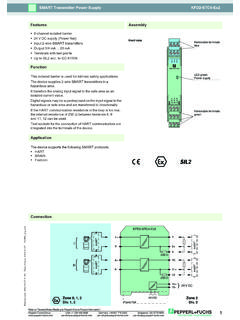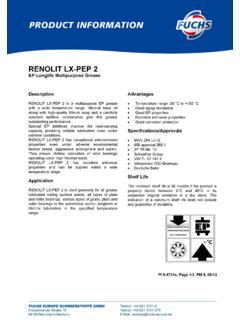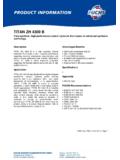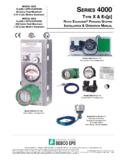Transcription of Photo by Warren Fuchs “Da Brooklyn dispatcher # …
1 Photo by Warren Fuchs Da Brooklyn dispatcher # 120 . April, May, June, 2005 Newsletter by Vincent Dunn, Deputy Chief FDNY (Ret). Firefighter's Death and Injury W hat exactly do they mean when they say "firefighter caught and trapped" or "in contact with"? What do these statistical categories mean to a firefighter? Actually, they are vague terms used by those who compile death and injury surveys of the fire service. They only serve the 1. statistician's need to fit our firefighting tragedies neatly into a single column. The following are understandable, comprehensible causes of firefighter death and injury. Read them and weep! Auto-exposure is the spread of flames on the outside of a building from one floor to the floor above. Flames can be sucked up to the floor above from window to window. Firefighters entering a window on the floor above a fire from a ladder or fire escape can have their escape path back to the window cut off by auto-exposure flame spread.
2 A backdraft is an explosion caused by the rapid ignition of smoke and fire gases occurring in a tightly sealed burning room. The trigger for a backdraft explosion is the fresh air that enters during firefighters' initial search and entry. The fire produces combustion gases and high heat temperatures and, since little or no air flows into the sealed room, consumes most of the room's oxygen. When a door to the superheated room is opened, air is introduced and completes the fire triangle necessary for a sudden rapid explosion. Firefighters performing search and rescue operations are some-times killed and injured by the blast of a backdraft. A blasting agent is an explosive material widely used at construction sites for demolition. It consists primarily of ammonium nitrate and a fuel such as No. 2 fuel oil. The danger of a blasting agent is often underestimated when compared with other explosives - a deadly error in judgment.
3 A blasting agent requires a stronger heat or shock source for detonation than a high explosive such as dynamite; however, when it does explode, the blasting agent is just as powerful as dynamite. Firefighters must realize the danger and treat the blasting agent in the same manner as high explosives. The flames of a fire are certainly enough to detonate a blasting agent. A tragedy several years ago in Kansas City in which six firefighters were killed when a blasting agent exploded during a truck fire is a grim reminder of that hazard. A BLEVE (boiling liquid expanding vapor explosion) occurs when a container of any liquid, but usually liquefied petroleum gas, ruptures. The BLEVE may result in a fireball created by the ignition of the suddenly released vaporizing liquids, in rocketing pieces of steel shrapnel flying through the air and in shock waves from the blast all of which can kill firefighters. Deaths from burns have occurred to firefighters positioned 250 feet away from large liquefied- petroleum containers; deaths from flying pieces of shrapnel at 800 feet away.
4 A boil-over is the sudden eruption of hot oil over the top of a large, burning crude-oil storage tank. A boil-over could occur after water from hose streams sinks to the bottom of the burning oil and is heated to its boiling temperature, expanding 1,700 times as it turns to steam 2. and violently forces the oil out of the tank. A boil-over could spray boiling-hot oil over firefighters operating hose lines near burning tanks. Carbon monoxide, a colorless, odor-less, explosive gas, is a toxic product of incomplete combustion. During a structural fire, there is usually insufficient oxygen for complete combustion to take place. The uncontrolled smoldering of a fire generates carbon monoxide. There may be gases in a fire area more toxic than carbon monoxide, but it is produced in large quantities that could be deadly. When mixed with air at low concentrations, 10,000 parts of carbon monoxide per mil-lion of air can cause death when inhaled for one minute.
5 A cellar is a below-grade floor level in a building. Firefighters die in cellars from carbon monoxide accumulation due to incomplete combustion, from oxygen depletion due to flash fires, from drowning in water-filled cellars, from breathing heavier-than-air gases that accumulate there and from flammable gas explosions during fire. Some cellars are more dangerous than others are. A cellar that's completely below grade without windows is more dangerous than a cellar that's only partially below grade or one that has windows to provide ventilation. Cellars in high-rise buildings do not have windows. Sub-cellars, the most dangerous type of below-grade area, have no windows and are two stories below the street level, directly below the cellar. A cellar becomes more dangerous after the fire has been extinguished. Smoldering embers generate carbon monoxide. Always ventilate and wear masks during cellar overhaul to prevent death from carbon monoxide inhalation.
6 A collapsing structure is defined as any portion of a burning structure that collapses due to fire damage. Firefighters out-side of burning buildings as well as those inside are killed by structural collapses. Unlike the other leading causes of fire-fighter deaths, when a building collapses during a fire, large numbers of firefighters die in a single event. Chicago lost 21 fire- fighters at a single structural wall collapse during a fire; Philadelphia lost 14 in a floor-and-wall collapse; Brockton, MA, lost 13 firefighters in a movie theater truss roof collapse; New York City lost 12 fire-fighters in a drug store floor collapse; in Boston nine firefighters died in a floor- and-wall collapse when a 100-year-old hotel under renovation suddenly fell; in Hackensack, NJ, five firefighters died when a truss roof collapsed during a fire in an auto dealership fire; in Seattle a floor collapse killed five firefighters; Lake Worth, TX, lost three firefighters at a lightweight truss collapse in a church; and in Houston two firefighters were killed in a lightweight roof collapse during a restaurant fire.
7 3. A collapse danger zone is the most deadly area on the fireground. Once collapse is anticipated and a danger zone defined, no firefighter should enter it. A collapse danger zone is the ground area over which bricks from a collapsing wall will fall. It's the distance away from the unstable wall equal to the height of the wall. When a brick or wood wall collapses in a 90- degree-angle collapse, it will kill any firefighter operating within the collapse danger zone; that is; a 20-foot-high wall collapsing at a 90-degree-angle will kill firefighters operating within 20. feet of the wall. A commercial building fire - in a store, office or warehouse - is more dangerous than a residence building fire. The number of firefighter deaths and injuries in residence fires is greater than those in commercial structure fires, but that's only because there are many more residence fires. Actually, the percentage of firefighters killed per incident is greater for commercial fires.
8 Firefighters should take extra precautions when responding to commercial building fires. Additional dangers are pre-sent that are not found in residence buildings: dangerous industrial processes using chemicals and flammable liquids, dangerous machinery, unusual floor layouts, heavy floor loads, large floor areas, high ceilings and greater fuel loads. Convection currents, the upward movement of heat by flame and heated smoke, are a dangerous type of heat transfer at a structural fire. They trap and kill firefighters operating on the floor above a fire and in cellars. Firefighters searching the floor above a fire can be cut off by flame and superheated smoke or gases flowing up an interior stairway they will not be able to retreat back down stairs filled with the rising convection currents of heat from the fire below them. Firefighters crouching as they battle a stubborn blaze in a cellar for a long time may not detect the heat and flame building up over their heads.
9 If the convection currents of heat and flame fill the stairway or flow up the stairs to the street level and suddenly ignite, firefighters could be trapped in the cellar without a means of escape. Disorientation is the loss of direction firefighters experience when searching a smoke-filled room. It happens primarily when firefighters fail to use an organized search technique when moving around the smoky room and prevents firefighters from returning to the safety of the door or window of entry. Disoriented firefighters often are killed by flashover or die from asphyxiation in smoke after their masks run out of air. And it doesn't take a large space for disorientation to occur: the bodies of firefighters have been found next to doors and windows in 10-by-10-foot rooms that had been filled with thick smoke. 4. Electric shock can be fatal. Electricity passing through the body may bring about violent muscular contractions of the heart; interrupt the breathing process or burn vital internal organs in the path of the electric current.
10 Most firefighters who are killed or injured by electricity come in contact with overhead utility wires when climbing ladders or operating in aerial platforms. Consider all electrical wires and equipment live and dangerous. An elevator must be considered a death trap during a fire in a high-rise building. Fire, water and heat can cause an elevator to operate in unpredictable ways, often with fatal results. The elevator may be called to a floor above the fire or to a fire floor that's fully involved with fire, trapping firefighters in the car. If an elevator unexpectedly becomes stuck between floors above the fire and rising heat and smoke turn the elevator shaft into a chimney flue, the trapped fire-fighters will die. Firefighters searching in smoke-filled hallways have walked into open elevator doorways and fallen down shafts to their deaths. An explosion is a violent combustion reaction of fuel, oxygen and heat that creates rapid expansion of gases strong enough to collapse an enclosing structure or create shock waves that break glass windows or knock down nearby firefighters.









